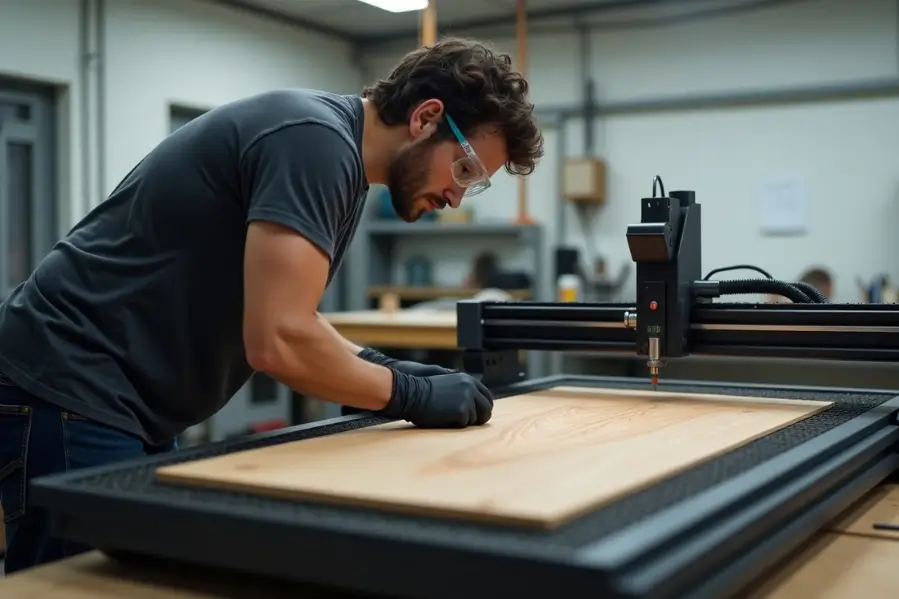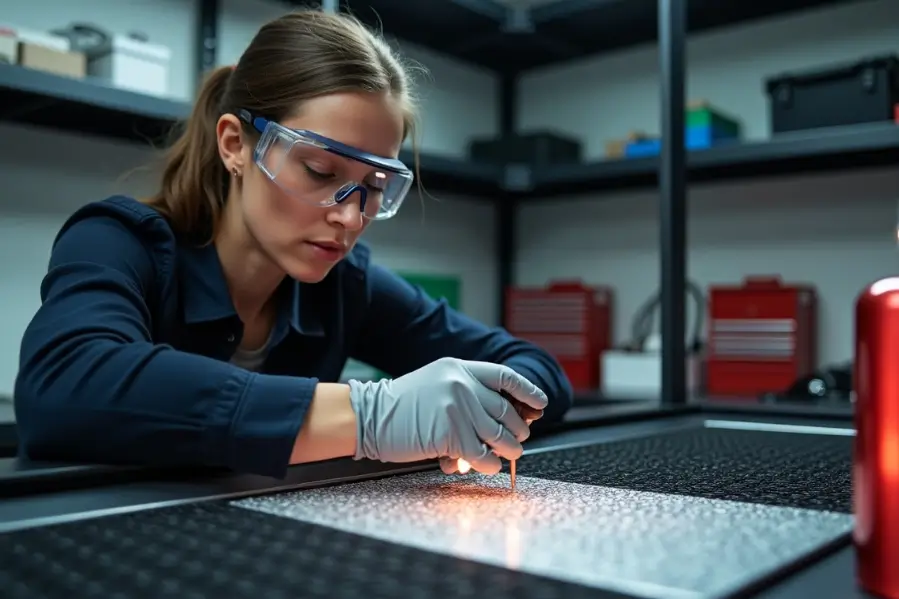Laser engraving at home allows you to create custom designs on wood, glass, leather, and more. But without the right safety steps, this creative process can become risky.
Every laser machine produces heat, fumes, and light that can harm your health if not handled properly. You need a well-ventilated space, protective gear, and a basic understanding of your equipment.
This guide will walk you through the essential safety tips. Follow them to stay safe while getting the most out of your laser engraving projects.
What to Know About Laser Engraving at Home

Laser engraving lets you create custom designs at home with speed and precision. Knowing the right tools, materials, and methods is key to getting started.
1. Types of Laser Engravers
There are several types of laser engravers available on the market, each designed for specific applications. The most common types are:
- CO2 Laser Engravers: These machines are versatile and can engrave a variety of materials such as wood, acrylic, glass, and leather. They generate a long wavelength of light suitable for engraving and cutting.
- Diode Lasers: Generally more affordable, diode lasers are effective for lighter materials like wood and plastic. While they may not have the power for heavy-duty projects, they are excellent for small, detailed engravings.
- Fiber Lasers: Ideal for metals, fiber lasers produce high-quality engravings on materials like aluminum, brass, and stainless steel. They have a shorter wavelength, making them suitable for harder surfaces and industrial applications.
2. Laser Engraving Materials
Choosing the right materials is crucial for successful laser engraving. Common materials that can be effectively laser engraved include:
- Wood: It provides a traditional look and can be easily engraved, making it popular for custom signage and gifts.
- Acrylic: A sharp, clean finish is achieved with acrylic, making it a favored choice for awards and decorative items.
- Glass: Laser engraving on glass creates stunning effects, commonly used for personalized drinkware and gifts.
Materials that cannot be laser cut include certain types of metals, thick plastics, and anything that may release harmful fumes, such as PVC.
3. The Laser Engraving Process
The laser engraving process starts with creating a design using computer software. This design is then sent to the engraving machine.
The machine uses a focused laser beam to etch the design onto your chosen material. Speed and power settings must be adjusted carefully to avoid burning or damage.
Safety is key. Always wear protective eyewear and keep your workspace well-ventilated to avoid harmful fumes and light exposure. Following these steps ensures better results and a safer experience at home.
Essential Safety Tips for Home Laser Engraving

Laser engraving at home is safe when the right steps are followed. Use proper gear, know your machine, and keep your workspace secure.
1. Personal Protective Equipment (PPE)
Wearing the right safety gear helps protect you during laser engraving. Laser safety glasses shield your eyes from harmful light, especially with powerful Class 4 machines.
If you’re working with materials that produce fumes, use a respirator mask. Long sleeves and proper clothing can also reduce the risk of skin exposure. Make sure all your gear fits well and meets safety standards.
2. Safety Features of Engravers
Many laser engravers include built-in safety features to protect users. These may include auto shut-off when the lid is opened and safety locks to prevent accidental exposure.
Some machines also have smoke detectors or fire alerts. Always check the manual to understand these features and choose a machine that follows Class 4 laser safety standards.
3. Maintaining a Safe Operation Environment
Set up your laser engraver in a well-ventilated area to clear out fumes and keep the air fresh. Use a window or exhaust system for proper airflow.
Keep a fire extinguisher nearby, rated for electrical and chemical fires. Make sure your workspace is clean, free of flammable items, and easy to move around. Stay informed about laser safety and follow the guidelines for your specific machine.
How to Use and Maintain Your Laser Engraver

Learn the right way to operate and care for your laser engraver to keep it running safely and efficiently for the long term.
1. Daily Laser Engraver Checks
Check your laser engraver before each use to keep it running safely and smoothly. Look over wires and connections to avoid electrical issues.
Use a simple checklist:
- Clean lenses and mirrors
- Check the cooling system
- Make sure the bed is level
Also, keep an eye on the laser’s power. If it seems weak or uneven, the machine may need recalibration.
2. Laser Optics Alignment and Cleaning
Keeping your laser optics aligned is key for good results. Misaligned mirrors or lenses can lower engraving quality or even damage the machine. Check and adjust them regularly based on your manufacturer’s instructions.
Clean the optics gently using:
- A microfiber cloth to prevent scratches
- A lens cleaner made for optical parts
This helps prevent dust buildup and keeps your engraver working at its best.
3. Controlling Fumes and Debris During Engraving
Laser engraving creates fumes and debris that can be harmful if not handled properly. Good ventilation is a must to protect your health.
Helpful tools include:
- A fume extractor to filter out harmful particles
- Air assist to clear smoke during engraving
Keep your workspace clean and check filters often. This keeps the air safe and helps your machine last longer.
How to Troubleshoot and Handle Emergencies

Learn how to spot common laser engraving issues and take quick action to handle emergencies safely and effectively.
1. Common Laser Engraver Issues
- Misaligned lasers can cause inaccurate engravings. Check and recalibrate regularly.
- Power fluctuations may lead to malfunctions. Use a stable power source to avoid issues.
- Faulty safety interlocks can make the machine unresponsive. Test safety features during routine checks.
- Cluttered workspaces increase fire risk. Keep the area clean and free of flammable materials.
What to Do in Case of a Fire
In case of a fire, act quickly and stay calm. Know where the emergency stop button is on your laser engraver as it can shut down the machine and help prevent the fire from spreading.
Keep a fire extinguisher nearby that is rated for electrical fires and make sure you know how to use it properly. Never use water on electrical fires since it can make the situation worse.
If a fire starts, prioritize your safety. Leave the area immediately and call emergency services. If it’s safe, use a fire extinguisher or sand to put out the flames and remove flammable items from the workspace.
Always keep an eye on your laser engraver while it is running. Staying alert helps catch problems early and reduces the risk of fire.
Final Thoughts
Laser engraving at home is not only a rewarding hobby but also a great way to start a profitable business. With the right safety practices, reliable tools, and consistent care, you can create high-quality products that stand out.
If you’re ready to get started or upgrade your setup, investing in the right machine makes all the difference.
Explore our top rated laser engravers and find the perfect fit for your next project.
Frequently Asked Questions
1. Is it safe to use a laser engraver indoors?
Yes, you can use a laser engraver indoors, but good ventilation is key. Fumes can damage parts like the lens and mirrors over time. A garage or separate workspace is ideal.
2. Should you wear a mask when laser engraving?
Yes, you should wear a mask when laser engraving. A proper respirator is needed to filter fine particles and harmful fumes. It must fit well to offer full protection.
3. What are the safety precautions for laser engravers?
Safety precautions for laser engravers include wearing the right protective gear, such as laser safety glasses and heat-resistant gloves. Always stay nearby and monitor the machine while it runs to quickly respond if any material catches fire.
4. What types of materials are safe for laser engraving at home?
Common materials that are safe for laser engraving include wood, acrylic, and certain types of leather. It is important to avoid materials such as PVC, which can release harmful gases when burned. Always consult the manufacturer’s guidelines for specific materials to ensure safety.
